
The Caridea, commonly known as caridean shrimp or true shrimp, are an infraorder of shrimp within the order Decapoda. This infraorder contains all species of true shrimp. They are found widely around the world in both fresh and salt water. Many other animals with similar names – such as the mud shrimp of Axiidea and the boxer shrimp of Stenopodidea – are not true shrimp, but many have evolved features similar to true shrimp.

The Stenopodidea or boxer shrimps are a small group of decapod crustaceans. Often confused with Caridea shrimp or Dendrobranchiata prawns, they are neither, belonging to their own group.

Palaemonetes, its common names include glass shrimp, ghost shrimp, feeder shrimp, is a genus of caridean shrimp comprising a geographically diverse group of fresh water, brackish and marine crustaceans. Conventionally, Palaemonetes included the following species:

Palaemonidae is a family of shrimp in the order Decapoda. Many species are carnivores that eat small invertebrates, and can be found in any aquatic habitat except the deep sea. One significant genus is Macrobrachium, which contains commercially fished species. Others inhabit coral reefs, where they associate with certain invertebrates, such as sponges, cnidarians, mollusks, and echinoderms, as cleaner shrimps, parasites, or commensals. They generally feed on detritus, though some are carnivores and hunt tiny animals.

Palaemon is a genus of caridean shrimp of the family Palaemonidae. The conventional circumscription of the genus Palaemon is probably paraphyletic. Molecular data suggest that Palaemonetes, as well as the genera Exopalaemon and Couteriella, are nested within Palaemon. Phylogenetic affinities in these groups correspond better with geographical origin than conventional genus assignments.
Procarididea is an infraorder of decapods, comprising only eleven species. Six of these are in the genera Procaris and Vetericaris, which together make up the family Procarididae. The remaining five species are only known from fossils and belong to the genus Udora, which cannot yet be assigned to any family. Use of molecular phylogenetics suggests that the procarids are the sister group to the Caridea, and are thus recognised as a separate infraorder, Procarididea.
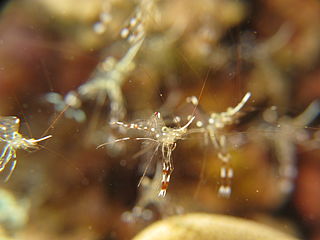
Urocaridella antonbruunii, common names clear cleaner shrimp or red-white cleaner shrimp, is a species of shrimp belonging to the family Palaemonidae. It was described by A. J. Bruce in 1967. It is one of the species that are known as cleaner shrimps.
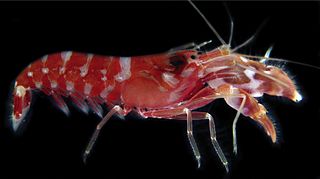
Alpheoidea is a superfamily of shrimp containing the families Alpheidae, Barbouriidae, Hippolytidae and Ogyrididae.

Nematocarcinoidea is a superfamily of shrimp, comprising four families – Eugonatonotidae, Nematocarcinidae, Rhynchocinetidae and Xiphocarididae. They share the presence of strap-like epipods on at least the first three pairs of pereiopods, and a blunt molar process.

Stenopus spinosus is a shrimp-like decapod crustacean belonging to the infraorder Stenopodidea.
Juxtastenopus spinulatus is a species of stenopodidean shrimp. It lives in the Red Sea, and across the Indian Ocean as far east as the Philippines. It is red or pink, up to 28 mm (1.1 in) long, with enlarged third pereiopods. Originally described in the genus Engystenopus, it is now placed in the monotypic genus Juxtastenopus, in the family Stenopodidae.
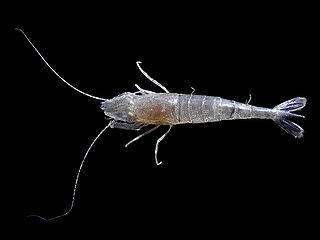
Crangon is a genus of shrimp.

Litopenaeus is a genus of prawns, formerly included in the genus Penaeus. It contains five species:

Thor is a genus of shrimp, containing the following species:
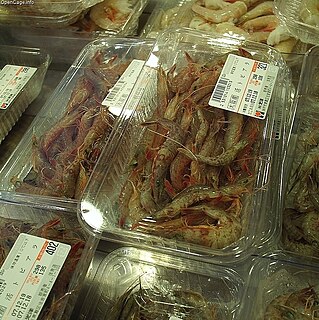
Trachysalambria is a genus of prawns, containing ten species. It was erected in 1934 by Martin Burkenroad, as a subgenus of Trachypenaeus, with T. curvirostris as its type species. That subgenus was elevated to the rank of genus in 1997 by Isabel Pérez Farfante and Brian Kensley. The ten species are:

Ancylomenes is a genus of shrimp, erected in 2010 to accommodate the group of species around "Periclimenes aesopius". Members of the genus are widely distributed in the warm oceans of the world, and live in association with cnidarians; most are cleaner shrimp.

Shrimp are decapod crustaceans with elongated bodies and a primarily swimming mode of locomotion – most commonly Caridea and Dendrobranchiata. More narrow definitions may be restricted to Caridea, to smaller species of either group or to only the marine species. Under a broader definition, shrimp may be synonymous with prawn, covering stalk-eyed swimming crustaceans with long, narrow muscular tails (abdomens), long whiskers (antennae), and slender legs. Any small crustacean which resembles a shrimp tends to be called one. They swim forward by paddling with swimmerets on the underside of their abdomens, although their escape response is typically repeated flicks with the tail driving them backwards very quickly. Crabs and lobsters have strong walking legs, whereas shrimp have thin, fragile legs which they use primarily for perching.

Prawn is a common name for small aquatic crustaceans with an exoskeleton and ten legs, some of which can be eaten.
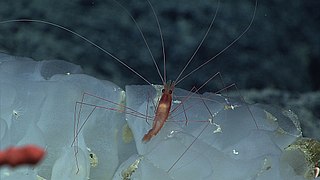
Nematocarcinus tenuisrostris, or long-legged shrimp, is a species of shrimp known from the Indian and Pacific Oceans.
Atyoida is a genus of freshwater shrimp in the family Atyidae. There are four species in the genus, each endemic to a different island group. The type species, Atyoida bisulcata, is endemic to Hawaiʻi and described by John Witt Randall in 1840.
















